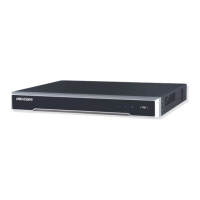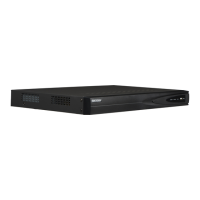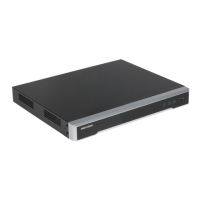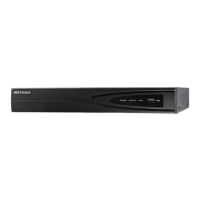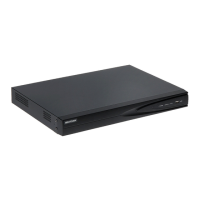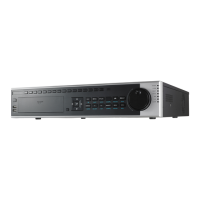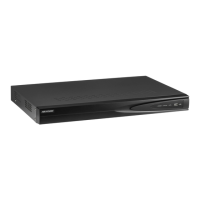Do you have a question about the HIKVISION DS-7604-HI-ST and is the answer not in the manual?
| Video Input | 4 channels |
|---|---|
| HDD Capacity | Up to 6TB |
| Compression | H.265+/H.265/H.264+/H.264 |
| Audio Input | 4 channels |
| Audio Output | 1 channel |
| Video Output | 1 channel VGA, 1 channel HDMI |
| Network Interface | 1 RJ45 10M/100M Ethernet interface |
| Frame Rate | Up to 30 fps |
| USB Interface | 2 USB 2.0 |
| Power Consumption | ≤15W |
| Operating Temperature | -10°C to +55°C |
| Operating Humidity | 10% to 90% |
| HDMI Output | 1 channel |
| VGA Output | 1 channel |
Details FCC compliance for digital devices, including interference limits.
Explains CE marking and compliance with EU directives like WEEE and Battery.
Lists general features including network connectivity, compression, and dual-stream support.
Covers simultaneous HDMI/VGA/CVBS outputs, live view options, and basic camera controls.
Details support for SATA and network HDDs, group management, and S.M.A.R.T. features.
Explains playback interface, scheduling, and recording types.
Describes exporting video data via USB/SATA and managing backup devices.
Covers alarm types, response actions, and automatic system recovery.
Includes user management, log search, and device configuration import/export.
Lists supported network protocols, port mapping, and remote access features.
Mentions SDK availability and development support for application systems.
Details the components and indicators found on the front panel of the device.
Explains how to use the included infrared remote control for device operation.
Describes how to connect and use a USB mouse for device control.
Explains the functionality of the on-screen soft keyboard buttons.
Identifies and describes the connectors and ports on the rear panel of the device.
Provides step-by-step instructions for powering the device on, off, and rebooting.
Guides through the initial setup wizard for essential device configurations.
Explains how to add and connect network cameras to the device.
Details methods for automatically or manually adding available online IP cameras.
Covers editing parameters and network settings for already added IP cameras.
Describes how to set up custom protocols for connecting compatible network cameras.
Explains the live view function and its associated status icons.
Details various functions available within the live view mode, like screen layouts and recording.
Explains mouse operations for navigation and interaction within the live view interface.
Describes features available when using an auxiliary monitor for live view.
Details the quick setting toolbar icons for immediate access to functions like record and zoom.
Details how to set up parameters for controlling PTZ cameras via RS-485.
Guides on setting preset locations, patrol paths, and movement patterns for PTZ cameras.
Explains how to define specific camera positions (presets) for PTZ cameras.
Describes how to activate predefined PTZ camera positions.
Details how to set up automated camera movement sequences (patrols) between key points.
Explains how to activate predefined PTZ camera patrol sequences.
Describes how to record and save PTZ camera movement paths as patterns.
Explains how to activate recorded PTZ camera movement patterns.
Details how to adjust image quality parameters like resolution and bitrate for streams.
Explains pre-record, post-record, expired time, and other recording settings.
Covers configuring stream type, resolution, and frame rate for the sub-stream.
Guides on setting up a schedule for automatic camera recording based on time.
Details how to set up motion detection areas, sensitivity, and trigger recording.
Explains how to configure alarm inputs and link them to recording actions.
Covers how to start and stop recording manually for all channels.
Allows setting up custom recording schedules for holidays.
Explains setting up redundant recording for enhanced data safety and reliability.
Details how to group HDDs and assign channels for recording to specific HDD groups.
Describes methods to protect recorded files from being overwritten, such as locking files.
Introduces how to play back recorded video files.
Explains how to play back recorded video for a specific camera channel.
Details how to play back recorded video within a specified time duration.
Guides on searching and playing back recordings based on event types like alarms or motion.
Explains how to use video tags for searching and locating specific recorded events.
Describes how to play back recorded files by searching system logs for associated events.
Details how to search and play back record files stored on external devices like USB drives.
Explains how to play video files frame by frame for detailed inspection.
Describes how to perform smart searches within motion detection events by analyzing specific areas.
Details how to use digital zoom to enlarge specific areas within recorded video.
Explains how to play back multi-channel recordings in reverse.
Introduces methods for backing up recorded video files.
Guides on quickly exporting recorded files to a backup device.
Details backing up files using normal video search criteria.
Explains backing up event-related recordings using search criteria.
Covers selecting and exporting video clips during playback.
Guides on configuring motion detection areas, sensitivity, and trigger settings.
Details how to handle external sensor alarms connected to the device.
Covers configuring settings to detect video loss and set alarm responses.
Explains how to detect video tampering and configure alarm responses.
Describes how to configure responses for various device exceptions like HDD errors.
Details available alarm response actions such as full-screen monitoring and email notifications.
Covers basic network settings like IP address, subnet mask, and DNS.
Details advanced network configurations.
Guides on setting up Point-to-Point Protocol over Ethernet (PPPoE) for network access.
Explains how to configure Dynamic DNS (DDNS) for network access.
Details setting up an NTP server for accurate system date and time synchronization.
Covers configuring SNMP for device status and parameter information retrieval.
Explains how to enable UPnP™ for seamless network device discovery and connection.
Details setting up a remote alarm host to receive event messages.
Covers configuring multicast settings for live view with many cameras.
Explains configuring RTSP for streaming media server control.
Details changing server and HTTP port configurations.
Guides on configuring HTTPS for secure data transfer and web access.
Explains enabling high-speed download for faster file transfer.
Details setting up email notifications for alarm and event detection.
Describes how to check real-time network traffic information like linking status and rates.
Covers network detection functions, including delay and packet loss testing.
Guides on testing network delay and packet loss to diagnose connectivity issues.
Explains exporting captured network data packets for analysis.
Details how to check the network connection status and network parameters.
Covers checking network statistics like bandwidth usage for IP cameras and streams.
Guides on initializing new hard disk drives before they can be used by the device.
Details how to add and manage NAS or IP SAN disks as network HDDs.
Covers managing HDDs in groups for recording purposes.
Explains how to set up and manage HDD groups for recording.
Details setting HDD properties like redundancy, read-only, or read/write.
Guides on allocating specific storage quotas for recorded files per camera.
Explains how to check the status of installed HDDs for potential failures.
Covers checking S.M.A.R.T. data for HDD reliability and anticipating failures.
Details how to detect bad sectors on the HDD to check its condition.
Explains how to configure alarms for HDD errors like 'Uninitialized' or 'Abnormal' status.
Guides on configuring On-Screen Display settings like date, time, and camera names.
Details how to mask specific areas in the video feed for privacy.
Covers adjusting image parameters like brightness, contrast, and hue for cameras.
Explains how to view system information.
Details how to view the device's name, model, firmware, and encoding versions.
Describes how to view the connection status of each connected camera.
Explains how to view recording status and parameters for each camera.
Details how to view alarm information for triggered events.
Covers viewing network configuration and connection status.
Explains how to view HDD status, free space, and property details.
Guides on searching, viewing, and exporting device log files.
Details how to export device configurations for backup or import to other devices.
Covers upgrading the device firmware via local backup or FTP server.
Explains how to upgrade firmware using a local backup device like a USB drive.
Details how to upgrade firmware using a remote FTP server.
Guides on restoring the device to its factory default settings.
Covers general device settings like language, output standards, and resolution.
Details how to configure Daylight Saving Time (DST) settings for the device.
Covers additional device settings like device name, output brightness, and auto logout.
Explains how to manage user accounts, add, delete, and set permissions.
Guides on adding new user accounts with specific roles and permissions.
Details how to remove existing user accounts from the device.
Explains how to modify user information, including name, password, and MAC address.
Guides on changing the administrator's password for enhanced security.
Provides instructions for logging out, shutting down, or rebooting the device.
Provides definitions for technical terms used throughout the manual.
Offers solutions for common issues encountered with the device, like display or HDD problems.
Addresses issues with the monitor display not showing an image after device startup.
Explains how to resolve the "Di-Di-Di-Didi" sound indicating HDD issues.
Troubleshoots issues where connected IP cameras show a 'Disconnected' status.
Addresses problems with IP cameras intermittently connecting and disconnecting.
Solves issues with black screens when connecting monitors via different interfaces.
Troubleshoots freezing issues during local video output.
Addresses problems with audio input or playback, including no sound or noise.
Solves image freezing issues during single or multi-channel playback.
Addresses the "No record file found" error when searching for recordings.
Lists compatible Hikvision IP camera models and their versions.
Lists compatible IP cameras from third-party manufacturers.
